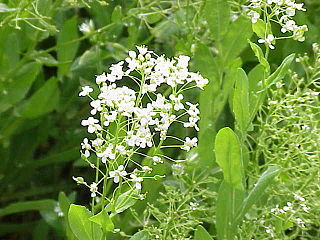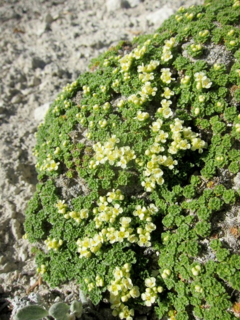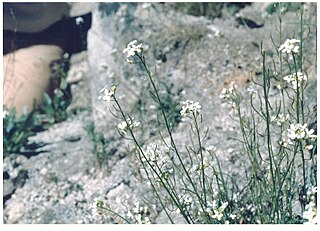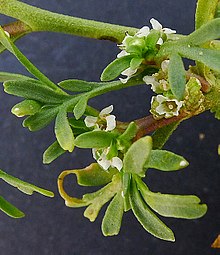
Lepidium is a genus of plants in the mustard/cabbage family, Brassicaceae. The genus is widely distributed in the Americas, Africa, Asia, Europe, and Australia. It includes familiar species such as garden cress, maca, and dittander. General common names include peppercress, peppergrass, pepperweed, and pepperwort. Some species form tumbleweeds. The genus name Lepidium is a Greek word meaning 'small scale', which is thought to be derived from a folk medicine usage of the plant to treat leprosy, which cause small scales on the skin. Another meaning is related to the small scale-like fruit.

Lepidium campestre, the field pepperwort or field pepperweed or field cress, is usually a biennial with some form of annual plant in the Brassicaceae or mustard family, native to Europe, but commonly found in North America as an invasive weed. The most notable characteristic of field pepperweed is the raceme of flowers which forks off of the stem. These racemes are made up of first small white flowers and later green, flat and oval seedpods each about 6 mm long and 4 mm wide. Each seedpod contains two brown, 2.5 mm long seeds.

Cardamine hirsuta, commonly called hairy bittercress, is an annual or biennial species of plant in the family Brassicaceae, and is edible as a salad green. It is common in moist areas around the world.

Lepidium draba, the whitetop or hoary cress, or Thanet cress, is a rhizomatous perennial flowering plant in the family Brassicaceae. It is native to western Asia and southeastern Europe and widely introduced elsewhere.

Hakea pachyphylla is a flowering plant in the family Proteaceae and is endemic to the upper Blue Mountains in New South Wales. It is a small shrub with stiff, needle-shaped leaves and clusters of yellow flowers. Formerly thought to be a Blue Mountains form of Hakea propinqua.

Banksia dallanneyi, commonly known as couch honeypot, is a species of prostrate shrub that is endemic to Western Australia. It only has a short above-ground stem, pinnatipartite or pinnatisect leaves, between thirty and seventy variously coloured flowers and glabrous, egg-shaped fruit.

Coronopus is a synonym for the accepted genus name Lepidium. It was applied to some species of flowering plants in the cabbage and mustard family Brassicaceae known commonly as swinecress or wartcress. These are generally low spreading annual herbaceous plants with many long stems, deeply lobed leaves and small white flowers. They have a strong scent, smelling like garden cress, Lepidium sativum, when crushed. Lepidium squamatus may be native to the Mediterranean but Lepidium didymum may be native to South America. Both species are widespread weedy introduced species in other areas.

Peltaria alliacea, or garlic cress, is a perennial plant in the family Brassicaceae, endemic to Southeastern Europe. The plant grows up to 60 cm (24 in) and flowers white from May to July. The plant is glabrous (hairless) with simple, entire leaves. The leaves are ovate, sessile and amplexicaule. When crushed they smell of garlic, hence the common name. The 3–4 mm (0.12–0.16 in) long white petals are shortly clawed. The orbicular, very flat silicula or seed, is pendent and has a size of about 6 by 6 mm. Its chromosome number is 2n=14.

Lepidium didymum, the lesser swine-cress, is a species of flowering plant in the family Brassicaceae.

Hakea trifurcata, commonly known as two-leaf, two-leaved hakea, or kerosene bush, is a shrub, endemic to the south-west of Western Australia. The species has two leaf forms, needle-like or oblong egg-shaped. Unlike most hakea species the fruit remain green at maturity and resemble the broader leaf form. The mimicry creates a camouflage, reducing predation of the seed by granivores in particular cockatoos.

Lepidium nanum, the dwarf pepperweed, is a plant species native to the US states of Nevada and Utah. It is known from four counties in Nevada but only one in Utah. It occurs in open, sunlit areas in the desert, often with gypsum, limestone, quartzite or chalky soils.
Iris falcifolia is a plant species in the genus Iris, it is also in the subgenus Iris and in the section Hexapogon. It is a rhizomatous perennial, from Uzbekistan, Kazakhstan, Afghanistan, Iran and Pakistan. It is a small plant, with sickle-shaped greyish-green leaves, lilac-violet flowers and darker veining, and a white or yellow beard. It is cultivated as an ornamental plant in dry, temperate regions.

Sandy iris is a species in the genus Iris; it is also in the subgenus of Iris and in the Psammiris section. It is a rhizomatous perennial, from Central Europe, found in Hungary, Austria, Romania, Czech Republic and Ukraine. It has grass-like leaves, a short stem and pale yellow flowers. It has had a mixed origin and was once Iris humilis subsp. arenaria, a subspecies of Iris humilis, until it was reclassified as a separate species. But many sources still state that it is either a synonym or subspecies of Iris humilis. It is cultivated as an ornamental plant in temperate regions.

Lepidium heterophyllum,, is a species of flowering plant in the mustard family which is native to parts of western Europe, growing in shingle banks, wasteland or cultivated fields.
Goodenia coronopifolia is a species of flowering plant in the family Goodeniaceae and is endemic to north-western Australia. It is a herb with mostly linear leaves, those at the base of the plant divided with narrow segments, racemes of yellow flowers with brownish-purple markings, and more or less spherical fruit.
Hedinia is a monotypic genus of flowering plants belonging to the family Brassicaceae. It only contains one known species, Hedinia tibetica.

Hewittia malabarica is a flowering plant in the monotypic genus HewittiaWight & Arn., belonging to the family Convolvulaceae and widespread throughout tropical Africa, Asia, and Polynesia. It is a climbing or prostrate perennial herb with slender stems and flowers that are pale yellow, cream, or white with a purple center, and large leaves that can be used as a cooked vegetable or used in folk medicine with the roots. The stems can be used to make ropes.

Sandbergia is a genus of flowering plants belonging to the family Brassicaceae. They are also in the Boechereae Tribe.
















